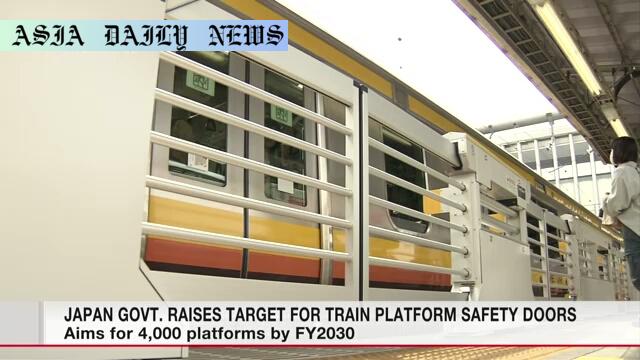Safety doors: Japan’s transport ministry raises the target to 4,000 platform safety doors nationwide by fiscal 2030.
Japan’s transport ministry sets a new target to install 4,000 train platform safety doors by fiscal 2030.
Currently, 2,647 platform safety doors are in place as of the end of fiscal 2023.
The ministry plans to encourage cost-efficient innovations in door designs and locations.
Subsidies and government support will aid train operators in reaching this goal.

Introduction: Addressing Passenger Safety
Japan’s transport ministry has announced an ambitious and proactive initiative to enhance passenger safety at train platforms nationwide. The goal is to install safety doors on 4,000 platforms by the end of fiscal 2030, demonstrating a clear commitment to reducing accidents and improving the public commuting experience. As of fiscal 2023, 2,647 platforms are equipped with safety doors, and with the current target of 3,000 doors expected to be met by the end of the fiscal year, the focus now shifts toward attaining this new goal.
Current Progress and Challenges
Safety doors, known for significantly reducing the risk of accidental falls and improving overall passenger security, are already in use at many stations across Japan. With 2,647 platforms outfitted, this infrastructure development has positively impacted the travel experience for millions of commuters. However, expanding this count to 4,000 presents unique challenges, particularly when addressing diverse train station layouts, variable platform sizes, and financial constraints. The transport ministry acknowledges these complexities and has outlined measures to address them effectively.
Innovating for Cost Efficiency
One of the critical aspects of achieving this target is cost management. By encouraging train operators to adopt innovative and adaptable door designs, the ministry aims to overcome infrastructure challenges while minimizing costs. Operators are expected to propose solutions that can be implemented across various station layouts, ensuring smoother scalability. The government further intends to support operators by providing subsidies and financial assistance, thereby reducing the economic burden associated with such upgrades.
Future Outlook and Implications
This initiative is not just an investment in public safety but also an example of forward-thinking infrastructure planning. The presence of safety doors has proven to be effective in reducing both accidental and intentional track intrusions, making it a crucial component of modern railway systems. If successful, Japan’s achievement of this goal could serve as a benchmark for other nations seeking to improve rail safety. Moreover, with safer platforms, public confidence in train travel is likely to grow, reinforcing Japan’s reputation for reliable and secure public transportation.
Conclusion: A Step Toward Safer Commutes
Japan’s plan to install 4,000 platform safety doors by 2030 is a testament to the country’s continuous strides in enhancing transportation safety. By promoting innovation, collaboration, and financial support, the government is paving the way for a safer and more efficient commuting environment. As this initiative unfolds in the coming years, it will undoubtedly strengthen Japan’s standing as a global leader in rail transport safety.



Commentary
The Significance of Train Platform Safety
Japan’s decision to upgrade train platform safety through the installation of 4,000 safety doors by 2030 exemplifies the country’s commitment to public safety and thoughtful infrastructure development. This move not only underscores the importance of accident prevention but also solidifies Japan’s place as a leader in advanced rail systems. The presence of these doors will help thousands of commuters daily, ensuring their protection while using public transportation.
Encouraging Innovation for Broader Impact
One of the standout aspects of this initiative is the emphasis on innovation and cost efficiency. By challenging train operators to develop new designs suitable for diverse station layouts, Japan is encouraging broader technological advancements. This not only benefits the local rail network but could also inspire global adoption of similar innovations. The government’s support through subsidies further reflects its proactive role in ensuring the success of this program.
Global Implications and Lessons
Safety on public transport is a global concern, and Japan’s approach can serve as a valuable example for other nations. The integration of safety features such as platform doors is indicative of a forward-thinking strategy that prioritizes human lives. If successfully implemented, this initiative will likely attract international attention, encouraging other countries to consider similar measures. This ripple effect could lead to safer rail networks worldwide, benefiting millions of passengers.
The Broader Vision of Transportation Safety
Ultimately, Japan’s push for enhanced platform safety aligns with a broader vision of improving public transportation systems. It highlights the role of government, private operators, and innovations in creating sustainable and secure commuting environments. As these efforts unfold, they carry the potential to reshape global perspectives on rail safety and infrastructure development.